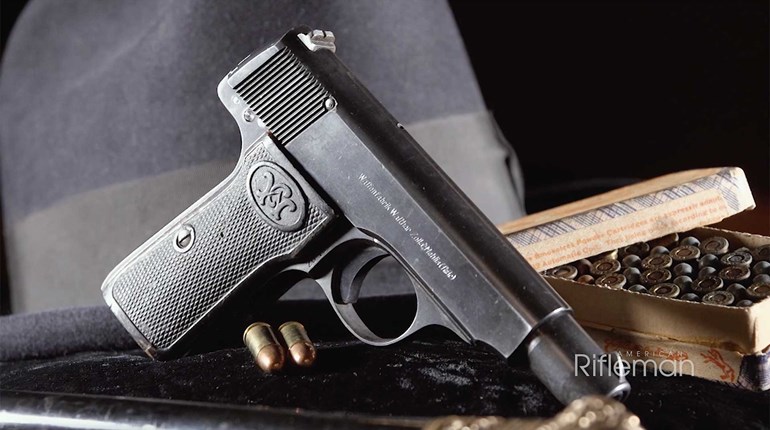
The plan embodied grand ambition—a breakthrough on the Western Front that would outflank and defeat the British Expeditionary Force (BEF) by capturing the channel ports supplying it. If that objective could be achieved, the Germans hoped that the French would be left with no choice but to seek an armistice that would finally bring an end to the Great War. Although the U.S. had joined the fight the previous year, German optimism increased appreciably on March 3, 1918, after Russia signed a separate peace in the form of the Treaty of Brest-Litovsk. The troops tasked with carrying out this ambitious operation were armed with the German military's principle battle rifle: the Mauser Gewehr 98.

Now that the fighting on the Eastern Front was at an end, Imperial Germany would be able to focus its full strength in the west, and it imagined this new offensive as marking the beginning of the end for the remaining allied combatants. Although it comprised five separate operations that ultimately reached beyond the summer solstice, the initial stage, code-named Operation Michael, kicked off on March 21 with an intense heavy artillery bombardment by 6,600 guns. Then, with a creeping barrage covering their advance, the infantry moved forward.
By this stage of the war, new weapons and tactics had changed the nature of ground combat, making 1918 look quite a bit different than 1914 had. In response to these changes, the Germans developed a specially trained force of assault troops known as Stoßtruppen and even gave them the perfect firearm for trench raiding: the MP.18 submachine gun. Despite this shifting paradigm of technology and tactics, and even as the MP.18 began to enter service, the backbone of German infantry firepower remained Paul Mauser’s incomparable Mauser Gewehr 98.
The origins of this rifle go all the way back to Mauser’s first model in 1871, and the design evolved quickly during the next 25 years. In April 1898, the German government’s Gewehr-Prüfungskommission (G.P.K. or “Rifle Testing Commission”) replaced its obsolescent Model 1888 Commission Rifle with an improved design that Mauser patented in September 1895.
This new Mauser chambered the 7.92×57 mm cartridge and employed a clip-fed, internal, staggered-row, box magazine with a five-shot capacity. The design incorporated a cock-on-open bolt and a long, effective extractor renowned for being strong and reliable. The Mauser Gewehr 98’s bolt was designed to engage the receiver with two forward-locking lugs as well as a third “safety lug” that was intended to provide added support in the event of a ruptured cartridge case. Additionally, two gas-escape holes on the bottom of the bolt and a gas shield at the cocking piece made this Mauser the safest rifle action in service anywhere.

For the first five years, the Mauser Gewehr 98 rifle was paired with a 226-grain, .318-inch, round-nosed bullet, but then in 1903 a 154-grain, .323-inch, Spitzgeschoss-pointed projectile replaced it. The Gew98’s 29.1-inch barrel was capable of accelerating that lighter spitzer bullet to 2,881 fps, a significantly higher muzzle velocity than the old round-nosed bullet could achieve. The change to the flatter-trajectory bullet brought a change to the weapon’s adjustable rear sight. From the start, the 98 Mauser used the visually distinctive Lange Visier “roller coaster” rear sight with graduations from 200 to 2,000 meters. With the change to a spitzer bullet, the 200-meter sight setting was actually more like 400 meters, which created a design challenge to be addressed.
Introduction of a shorter Lange Visier rear sight and reduction of the height of the front-sight blade provided a solution that would carry the Mauser through to the Armistice of 1918. A wooden stock, extended bayonet lug and half-length cleaning rod finished out the 49.2-inch long rifle. For its day, the Gew98 was a strong and reliable infantry arm that is remembered today as the ultimate military bolt-action rifle.
Weighing 9 pounds, the Mauser Gewehr 98 was used in combat for the first time during the Boxer Rebellion in 1900. Then, when Europe descended into war 14 years later, it still ranked as one of the finest designs in the world. The experience of combat during the opening years of the Great War only reinforced that fine reputation as it fought from Tannenberg to Gallipoli, where it was put to good use by Turkish troops. On the Western Front, it proved itself from Mons to Verdun, but as the war changed, so did the Gew98.

To prevent the mud of the trench environment from fouling the weapon, the Generalquartiermeister began issuing a sheet-metal dustcover. To increase the volume of fire that riflemen were capable of producing, an extended 25-round grabenmagazin (trench magazine) was also introduced. The Germans even converted some Mauser Gewehr 98 rifles to accept a detachable monocular optical sight that superimposed a pyramidal aiming point over the target, improving the sight picture. However, these accessories did not fundamentally alter what is considered by many to be the best bolt-action rifle ever made.
Not even Paul Mauser’s finest design could change the course of a war that was stretching the German Empire to its breaking point. In the end, Operation Michael fell far short of expectations. Although it achieved a breakthrough along the 43-mile front between St. Quentin, Arras and La Fère, that breakthrough never reached the rail junction at Amiens, so it never reached the channel ports that would have cut off the BEF from its supplies.
The French were, therefore, not driven to sue for peace. The Americans would soon begin fighting with increasing strength and confidence on the Western Front, and Germany would soon begin running out of time. Not even the mighty Mauser Gewehr 98 could change the inevitable course of that history.




































